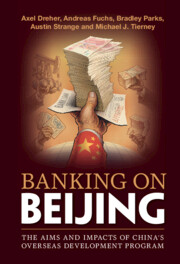Book contents
- Banking on Beijing
- Banking on Beijing
- Copyright page
- Contents
- Figures
- Tables
- Acknowledgments
- Abbreviations
- 1 Why Do We Know So Little about the Aims and Impacts of China’s Overseas Development Program?
- 2 The Journey to Global Creditor
- 3 Counting and Comparing Apples and Dragon Fruits
- 4 Follow the Money
- 5 Apples and Dragon Fruits
- 6 Aid à la Carte
- 7 Paving the Way to Growth and Development?
- 8 Poisonous Dragon Fruits?
- 9 Banking on the Belt and Road
- Postscript: Analysis of China’s Overseas Development Program During the BRI Era With an Updated Dataset
- References
- Index
5 - Apples and Dragon Fruits
How Does China Allocate Aid and Credit across Countries?
Published online by Cambridge University Press: 21 April 2022
- Banking on Beijing
- Banking on Beijing
- Copyright page
- Contents
- Figures
- Tables
- Acknowledgments
- Abbreviations
- 1 Why Do We Know So Little about the Aims and Impacts of China’s Overseas Development Program?
- 2 The Journey to Global Creditor
- 3 Counting and Comparing Apples and Dragon Fruits
- 4 Follow the Money
- 5 Apples and Dragon Fruits
- 6 Aid à la Carte
- 7 Paving the Way to Growth and Development?
- 8 Poisonous Dragon Fruits?
- 9 Banking on the Belt and Road
- Postscript: Analysis of China’s Overseas Development Program During the BRI Era With an Updated Dataset
- References
- Index
Summary
In this chapter, we use the new data to investigate which factors influence the allocation of Chinese development finance across countries, and how these motivations compare to those of traditional donors and creditors such as the World Bank. We specifically test the claim that Beijing is primarily using its economic largesse to cement alliances with political leaders, secure access to natural re- sources, and create exclusive commercial opportunities for Chinese firms. We run statistical models to examine the cross-country allocation of Chinese aid and debt, arguing that these two flows are motivated by different strategic objectives. Our results show that Chinese aid and debt are means to different ends. Like Western donors, Beijing allocates aid in response to levels of poverty and uses aid to reward countries that adopt its foreign policy positions and punish those that do not.Contrary to the conventional wisdom, Beijing is no more likely than major Western donors to provide aid to corrupt or authoritarian regimes. None of these findings are consistent with the notion that China is a “rogue donor” compared to its Western peers. However, Beijing’s loans issued at or near market rates are more likely to go to corrupt and authoritarian countries. The conflation of aid and credit seems to be at the heart of the confusion: Western politicians and journalists use “rogue donor” as a shorthand term for all of China’s overseas development projects, but many of these projects are not aid.
- Type
- Chapter
- Information
- Banking on BeijingThe Aims and Impacts of China's Overseas Development Program, pp. 122 - 158Publisher: Cambridge University PressPrint publication year: 2022

